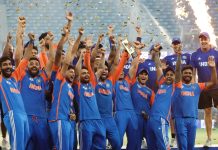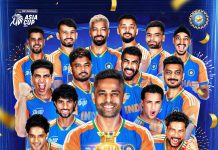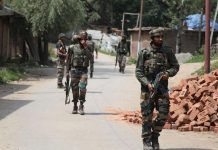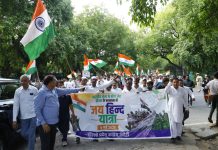
L’ affaire Swaraj
Swaraj found herself in a corner. How could the external affairs minister help an absconder, a person who had run away to escape punishment for his crimes? After all, the Income Tax and Enforcement Directorate (ED) were involved in the investigations of several cases against him. The two agencies had asked LaMo to appear before them, but the latter had refused to do so. The BCCI had found him guilty and stripped him off all the posts, including the head of IPL.
The external affairs minister said she had done so on “humanitarian grounds” because Minal, LaMo’s wife, had cancer. The BJP and RSS batted for her. LaMo waved an alleged letter from Interpol that there was no blue corner notice against him. He added that a high court order had allowed him to use his passport. Hence, he was free to travel anywhere.
Interestingly, LaMo had in 2014 tweeted a picture of himself and ‘brother’ Ron Noble, secretary general (now retired) of Interpol, the UN-mandated agency meant to battle transnational crime. Contacted by media recently, he said at no time had India requested a blue notice against LaMo.
Other scandals then fell out of Swaraj’s cupboard. Her husband admitted he was LaMo’s lawyer for two decades. Her daughter Bansuri was among the lawyers who helped LaMo get back his passport through a court order. Another lawyer was Ankur Chawla, son of journalist Prabhu Chawla. After the order, LaMo had sent them a ‘thank you’ email.
In August 2013, when Swaraj was the head of Opposition in the Lok Sabha, she asked LaMo if he could help her nephew Jyotirmay get admission in the UK. Within days, LaMo wrote to Vaz, “Mrs Sushma Swaraj called to see if we can do anything to help her nephew get into the law program at Sussex. Can you help with this. Much love. Lalit.”
Kirti Azad, the former cricketer and BJP’s Member of Parliament, alleged that Jaitley was behind the leak of Vaz’s emails. At least, he was the one who alerted an Indian news channel to rake up The Times sting. He said that LaMo alone cannot be blamed for the ed cases against him; all members of the IPL Governing Council and BCCI Executive Committee should be investigated. If the ed expands the scope of its inquiry, Jaitley, Pawar, Shukla and Srinivasan could be in trouble.
Raje in the picture
In his bid to prove that Swaraj had acted on humanitarian grounds, LaMo dragged the Rajasthan chief minister into the ongoing controversy. He claimed that Raje had accompanied his wife to Portugal twice, in 2012 and 2013, for treatment. This was the period when LaMo couldn’t travel since the UK had refused his travel documents. He added that he knew Raje for 30 years, and “she is a close friend of the family and my wife for a long time”. Here was another twist to the tale.
According to Modi, while he was fighting the travel case in the UK, Raje agreed to be one of the witnesses for him. However, “Unfortunately by the time the case went to trial, she was already chief minister, so she did not come to become a witness. The statements she gave is all on record in the courts.” While she supported LaMo’s bid to travel to Portugal, her document included a confidentiality clause that her name shouldn’t be revealed to Indian authorities.
It is true that LaMo’s rise in cricket administration was masterminded by Raje. In 2003, the latter became the state’s chief minister for the first time. The next year, she promulgated the Rajasthan Sports (Registration, Recognition & Regulation of Associations) ordinance. Its purpose, say sources, was to help Modi to become the head of the Rajasthan Cricket Association (RCA). In those days, LaMo was a member of RCA, which was a stronghold of the Rungta family. The family, with 57 members supporting it, who were either family members or loyalists, enjoyed a majority in the association.
One of the clauses of the ordinance was that all sports associations would be disbanded and registered afresh. Another stated that individual members of the associations would not be allowed to vote for the various posts of the respective institutions. Only the office bearers of district-level sports associations and primary sports bodies could contest such elections. The ordinance shook the ground beneath the feet of the Rungtas. Since the 57 individuals who owed allegiance to the family couldn’t vote, it wasn’t sure of the victory in the subsequent RCA elections.
After the Rajasthan High Court dismissed the Rungtas’ petition that challenged the ordinance in December 2004, it paved the way for Modi to become the head of RCA in 2005. He ruled like a cricket czar. In fact, it was alleged that he became Raje’s extra constitutional authority, and oversaw sensitive and crucial government files. He had a finger in every official pie, be it real estate, mining or liquor. He amassed vast wealth, and purchased havelis (mansions) for his wife. LaMo denied these charges; he said he was hardly in Jaipur, the capital of Rajasthan, to look at government files or interfere in state policies.
Rise and rise of LaMo
Lalit Modi’s entry into RCA marked his rise to greater heights in the BCCI. In 2004, Pawar ran for the BCCI president’s post. He lost by one vote to Ranbir Singh Mahendra, who was handpicked by Jagmohan Dalmiya, the incumbent BCCI chief, who then ruled cricket like his fiefdom. What angered Pawar was that he lost because of a second vote by Dalmiya, who insisted that he was allowed to cast it as the outgoing president. The next year Pawar took on Mahendra again. This time he was unwilling to accept defeat. As the RCA head, LaMo rooted for Pawar, who won easily in the 2005 BCCIelections.
The reward that LaMo got was a key responsibility; he was asked to monitor BCCI’s commercial contracts. According to his personal website, “Under Lalit’s stewardship, Indian cricket enjoyed a commercial revolution. Through a series of innovative partnerships with leading brands and broadcasters including Nike, Sahara, Sony, ESPN and Viacom, Indian cricket’s revenues increased seven fold between 2005 and 2008. In 2008, BCCI enjoyed record annual revenues of $1 billion.”
It was during Pawar’s reign in BCCI that LaMo realised an ambition that he had nurtured for nearly two decades. He had pushed the BCCI several times to start a league that would feature teams, owned by business groups, and showcase international cricketers. However, he was shunned, especially by Dalmiya, who said ‘no’ to the participation of foreign players. LaMo got his opportunity when Zee Group’s owner, Subhash Chandra, launched a renegade league. In 2007, with Pawar at the helm, the BCCI urged LaMo to start the IPL before Chandra stole the thunder and lightning.
Between 2008 and 2010, Modi could do no wrong. IPL was valued at over $4 billion as viewership boomed. No one had the gall or guts to point a finger at him who was backed by Pawar. He was the politician’s blue-eyed boy, who had discovered a huge vein of gold through the T20 league. Unfortunately, jealousies brewed within the board. Several officials, like Srinivasan, who was first treasurer and then secretary, and Shukla, who headed the marketing committee, waited for their chances.
Brushes with Chidambaram
The genesis of LaMo’s disgraceful decline can be traced to late 2008 and early 2009, when he clashed with Chidambaram, who was then home minister. The second season of IPL in 2009 was scheduled in the months of April and May. The national elections were to be held in the same period; therefore, Chidambaram said he could not provide security for the league. A peeved Lali Modi had to hastily shift it to South Africa. He never forgot the slight; neither did the home minister.

When LaMo shifted IPL-2 to South Africa, the BCCI transferred huge funds to that country to finance the costs and pay Cricket South Africa for the various services. One of the main cases against him is that the RBI’s permission was not sought, as required by law, and the transactions became illegal. LaMo blames Srinivasan who, he says, took the decision to bypass the RBI . He maintains that he had no financial authority, which was appropriated by Srinivasan.
After the BCCI sacked LaMo in 2010, the night of the finals of IPL-3, the latter flew to London. He had a valid passport at that time. It was Chidambaram who cancelled his passport in 2011, which LaMo claims was illegal. The Modi-Chidambaram spat continued when, in 2013, Chidambaram, the then finance minister under whom ed functioned, met his UK counterpart, George Osborne, then chancellor of the exchequer. A spokesperson of the UK treasury office said that the “Indian finance minister raised the question of Mr. Lalit Modi’s resident status with Mr Osborne.”
Chidambaram has raised several questions against NDA-2. He contended that the government should have appealed against the high court order in the passport case. He said that Swaraj should have asked Lalit Modi to apply for travel documents to the Indian High Commission in London, and not the UK authorities. Once LaMo’s passport was cancelled and until the high court order, how did the UK allow him to reside in the country? Finally, did NDA-2 take any measures to seek help from the UK in a bid to get LaMo back to India and serve summons to him?












